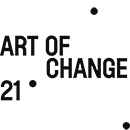When did the environment first become a theme in your work?
Living in Beirut, I started to smell pollution in the 2000s on the way to Fine Arts school every day. I felt that the air was very polluted and it was entering my lungs. We also had a big waste crisis a few years ago, alongside the frantic race to destroy the Lebanese mountains to build buildings instead! It is a mix of my feelings, as well as these aberrations and dysfunctional actions around me, that have awakened my sensitivity. Since then, I have documented myself, I have tried to act. When I started to paint as an autodidact, the subject came to me by itself. I didn’t think for a second, “What should I paint?” Since then, all of my paintings speak only of the environment, with treatments and materials that never stop evolving.
Why the choice of painting?
I was influenced by my art history lessons from the third year at the Lebanese Academy of Fine Arts, mainly by the contemporary period, abstract art, then minimalism, then Dada and conceptual art. Artists like Joseph Beuys, Robert Rauschenberg, Tapiès, De Kooning and Anselm Kiefer helped me to discover the possibilities of painting, a medium which is always the same, in a rectangle or a square or on a canvas or on wood, but hasn’t ceased to evolve through the centuries, and hasn’t ceased to dazzle either. Painting is, for me, eternal but never “finished”. It’s up to the spectator to decide, to interpret, to appropriate it.
Regarding the materials, by wanting to start from the ecological concept, it seemed obvious to me to use natural materials alongside oil paint. I introduce sand, pebbles, bark, straw, branches, leaves, cardboard, wood, lime…
What are the environmental issues that mobilize you the most?
Firstly the air. Do we realize what has become of the air on Earth? With massive deforestation, forest fires and the pollution we generate, the air has become noxious. We are in denial. With my paintings Wounded Sky, Dead Leaves, Trees Where Have You Gone? I try to point the finger, to raise awareness on the subject, while showing the beauty of the Earth. I never act explicitly, I aim to connect sensitivity to consciousness by indirect, purely artificial means. Sometimes the titles of my works betray this intention!
We exploit its unlimited resources: mines, quarries, deforestation, construction… In the “Earth” series I show the wounds, the mines, but also the colors, the textures, and the geological richness of our Earth. In my approach, anger is never far from attachment, the will to mobilize always in connection with beauty.
How is the situation with covid and its aftermath in Beirut where you live? Do you have confidence in the resilience of your country?
Covid appears to be a minor problem. Faced with the current economic situation and the impact of the explosion of August 4, 2020, the Lebanese people no longer care about Covid but rather seek their food on a daily basis. We had been filled with hope with the October 2019 revolution, but unfortunately it failed to overthrow the men in power. Today, people no longer have the strength to demonstrate. Everyday it’s a struggle to get a full tank of gas, a few hours of electricity a day, and not to go to bed hungry. But Lebanon has always lived that way. It gets up after years of crisis only to sink again. Nevertheless, it remains a Mediterranean country, where the sun manages to keep the sparks of life, of energy, of celebration, among these people who are always warm and who always seek to reach for the stars.
Alice Audouin
Tamara Haddad link
July 2021
Credit : photo courtesy of the artist
Find all the articles from Impact Art News n°32 – July / August 2021
To subscribe to Impact Art News (free) : here

